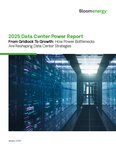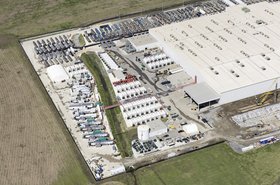Investors, clients, and partners increasingly expect organizations to provide comprehensive environmental impact disclosure. But despite companies’ good-faith efforts to provide accurate reporting, many are failing to account for a full 65-95 percent of their greenhouse gas (GHG) footprint: Scope 3 emissions. As a result, stakeholders receive only an incomplete picture of the business’ sustainability, and the organization misses an opportunity to assess and minimize the most significant source of their GHG footprint.
It’s time for data centers to resolve this gap in coverage and showcase to stakeholders and clients their commitment to achieving their sustainability goals.
Scope 3 emissions are underreported
By their nature, Scope 3 emissions are both the largest contributors to a given organization’s carbon footprint, and the most difficult to track. They comprise all emissions that are caused by activities from assets not owned or controlled by the reporting organization, but that the organization indirectly impacts through its value chain. Since the reporting organization doesn’t own or operate these assets, accessing their emission records can be a challenge - hence the frequent underreporting.
However, leaders have already emerged to overcome this lack of transparency: over 3,000 companies have reported scope 3 emissions under the Carbon Disclosure Project. Such companies are taking advantage of the economic, reputational and environmental benefits of improved transparency before others. These leaders are also better equipped to manage existing and potential regulations, such as Germany’s mandate that companies show responsibility for social and environmental issues tied to their global supply chain networks by 2023. Investors and other stakeholders are paying attention to these global developments and seeking reassurance that companies can manage any potential risks from potential U.S. regulations.
As supply chain sustainability draws increased attention from stakeholders, scope 3 emissions data must be included in carbon accounting to provide an accurate assessment of a data center’s climate impact. Once this data is widely available, companies can then act to reduce these emissions: for example, improving the sustainability of their energy storage practices through the use of battery chemistries with low climate impact (such as nickel-zinc).
Such reporting and actions will help resolve the significant gap in stakeholders’ ability to understand and compare carbon footprints.
Batteries can affect Scope 3 emissions
As data centers and their customers undergo growing expectations to disclose scope 3 emissions, they can report better and lower their footprint by considering the energy storage systems that are part of the Uninterruptible Power Supply (UPS) . The battery chemistry tied to a data center’s UPS offers significant trade-offs for their supply chain’s sustainability.
For example, nickel-zinc (NiZn) batteries are a more sustainably sourced and environmentally friendly alternative to other battery chemistries used in data centers, such as lead-acid and lithium-ion. A Climate Impact Profile by Boundless Impact Research and Analytics compared the environmental impact of of lead-acid, lithium and NiZn batteries, suggesting that NiZn has advantqages in GHG emissions, water footprint, energy footprint, and volatile organic compounds. The research was paid for by ZincFive, and found the following:
- Material Use
Nickel and zinc are respectively four and five times more abundant in the earth’s crust than lithium and lead. In addition, while lead exposure is a global health concern and lithium’s reactivity to air and water makes it a fire hazard, nickel and zinc are non-toxic and non-flammable. - Greenhouse Gas Emissions
Since nickel and zinc sourcing require fewer emissions and NiZn battery manufacturing’s carbon footprint is lower, users purchasing $1M of NiZn batteries save 148,255 tons of CO2e - a 537 percent improvement over lithium, and a 1,700 percent improvement over lead-acid batteries. - Carbon Payback Time
Carbon Payback Time (CPT) measures the time it takes for a battery to offset its GHG footprint by supplying more renewable resources to the electricity grid. NiZn chemistry’s CPT is between 0.16 and 0.21 years - four times faster than lithium-ion and lead-acid batteries. - Volatile Organic Compounds (VOCs)
Emitted as gases from solids - including those used to produce lithium-ion and lead-acid batteries - VOCs are infamous for causing short-and long-term adverse health effects. A healthier alternative, NiZn batteries do not use VOCs in production. - Water Footprint
Even including water requirements for raw material extraction, a NiZn battery still demands 96 percent less water than the average lithium-ion battery. - Energy Footprint
The energy footprint for NiZn is 23-33 percent less than that of lithium-ion batteries and lead-acid pure lead batteries.
Combining these metrics, NiZn had a 9.4 out of 10 impact score on its overall performance, with higher scores representing higher positive environmental impact. This score compares favorably to other battery chemistry options.
Quantifiable impact
Driven by pressure from investors, regulators and the general public, demands for scope 3 emission transparency are gaining momentum. Data centers who stay ahead of the competition in reporting and addressing scope 3 emissions will attract customers and investors seeking comprehensive disclosure and commitment to sustainability. This not only improves data centers’ own sustainability, but also attracts environmentally aware clients to them.
As efforts continue to make scope 3 accounting more straightforward and widespread, the availability of scope 3 level emission data for energy storage systems has created a welcome opportunity for data centers to reduce their climate impact. NiZn batteries have shown across a myriad of sustainability metrics that they help companies minimize their supply chain impacts. This set of sustainability data for battery sources helps data centers compare existing battery chemistries, as well as potential ones.
Already one of the largest industrial adopters of green energy, data center operators’ logical next step as energy sustainability leaders is to pioneer the accounting and reduction of scope 3 emissions. By helping quantifiably reduce scope 3 emissions, NiZn batteries will let early reporters showcase that advantage and set an example for other industries worldwide.
The Climate Impact Profile report is here





